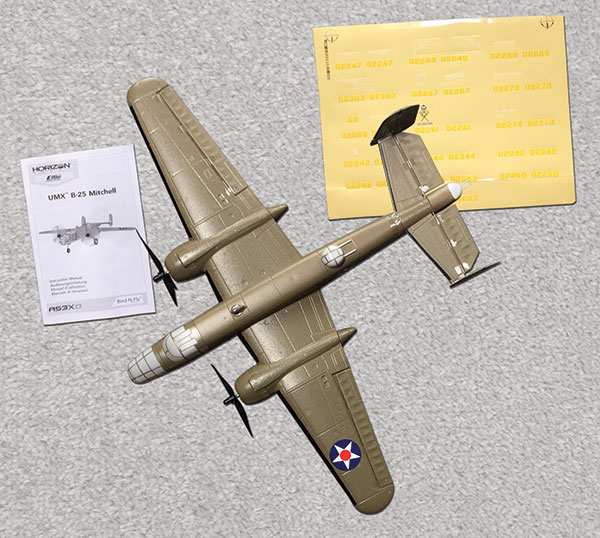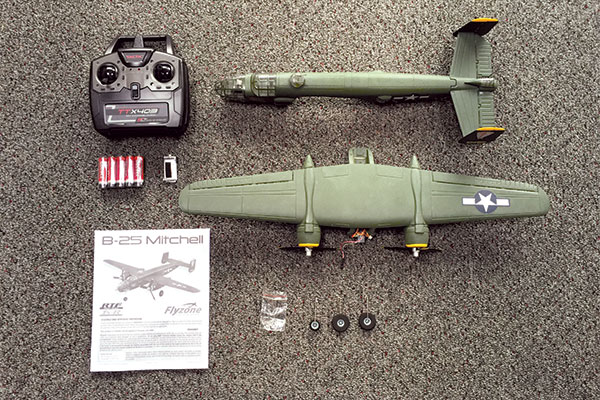Worth a Closer Look: Two micro B-25s

New product releases As seen in the December 2016 issue of Model Aviation.
E-flite UMX B-25 Mitchell BNF Basic
Specifications Wingspan: 21.65 inches Length: 17.17 inches Flying weight: 3.30 ounces Minimum required radio: Four channel Recommended battery: 300 to 500 mAh 1S Street price: $119.99Bonus video
The UMX B-25 Mitchell BNF Basic comes completely assembled, painted, and ready to fly right out of the box. To complete the model, you need a four-plus-channel transmitter with Spektrum DSMX/DSM2 2.4 GHz technology, a 300 to 500 mAh 1S 3.7-volt LiPo battery, and a LiPo battery charger. After taking the model out of the box, I was impressed with its scalelike detail, including its panel lines, scale guns, three-blade propellers, and the airplane’s accurate-looking color. It even includes a decal sheet that lets you choose any of the 16 Doolittle Raiders airplanes to customize your aircraft! I chose the markings that I liked and I applied them using a small pair of tweezers. I checked the B-25 to make sure everything looked okay. Although the airplane is ready to fly, you should always check the hinges, pushrods, motors, propellers, and anything else that might have been overlooked during the manufacturing process. Then I proceeded to bind the model with my Spektrum DX8 transmitter without any issues. I used the recommended 300 mAh LiPo battery for all of my test flights. The battery is installed in the nose and secured with a small piece of hook-and-loop material. Use only a small piece on the battery because it can be slightly difficult to remove. The nose battery hatch is held in place with magnets and can be easily removed for access to the compartment.

I checked the flight controls for proper movement and direction. I had to make one correction because the rudders were slightly off center with neutral rudder trim. I adjusted the linkage using a pair of needle-nose pliers and it was ready to go. You can fly without the removable landing gear to simulate retracted gear. I normally fly off of grass, so I made most of my flights with the gear off; however, I needed to test the model with the gear installed, so I took it out to a local flying field with a beautiful paved runway. The nose gear on the airplane is steerable, and I found that while taxiing, the airplane can turn a tight circle when needed. My first flight was straightforward and uneventful. A six-channel receiver featuring AS3X technology is installed. This gives the model a solid, smooth feel in the air. It tracked well on the takeoff roll. I took off, made a few circuits and a few small trim adjustments, and proceeded to test the aircraft’s stall characteristics. With the AS3X system, stalls were clean and easily recoverable. I made a few slow, scalelike flybys. The model really looks great flying low and slow! I set up for landing, keeping the nose high and touching down on the main landing gear. Yes, the airplane is a scale model of a World War II bomber, but I couldn’t resist doing some sport aerobatics with it. The aircraft has a semisymmetrical wing and good power, allowing it to easily perform loops, rolls, and even inverted flight. Horizon Hobby: 4105 Fieldstone Rd., Champaign IL 61821; Tel.: (800) 338-4639; website: www.horizonhobby.com
Flyzone B-25 Mitchell RTF
Specifications Wingspan: 21.7 inches Length: 17.2 inches Flying weight: 2.7 to 2.9 ounces Minimum required radio: Four channel Recommended battery: 250 mAh 1S Street price: $109.99 (Tx-R); $119.99 (RTF)Bonus video
I received the RTF version of the Flyzone B-25 for my review. It comes complete with a Tactic four-channel SLT radio system with a built-in battery charger, 1S LiPo battery, and five AA batteries. A transmitter-ready (Tx-R) version is also available that includes a separate LiPo battery charger. Upon removing the aircraft from the box, I was impressed with its looks. It is modeled after the beautiful B-25 Mitchell called Heavenly Body. The model has some nice scalelike details, including clear plastic cockpit windows, gun turrets, panel lines, painted propeller blades, and beautiful markings. The B-25 requires some basic assembly. You have to plug in two connecters from the wing into the receiver, and then attach the wing to the fuselage, which is held in place by two screws. The basic assembly lets you inspect the inside of the fuselage for loose pushrods, or anything else that might need attention from the production process. My model was fine, but it is a good idea to check.

Next, I installed the five AA batteries in the transmitter and charged the LiPo battery using the built-in charger. I installed the battery in the nose of the model and checked the flight controls for proper direction and movement. I also ran up the motors to check the power and to make sure they were working okay. It was a good thing that I did this because my right propeller flew right off the airplane! I also had a little trouble tightening the propeller when I tried to reinstall it. I ended up putting some gap-filling CA adhesive on the propeller shaft to act as threadlocker because I did not want the propeller to come off in flight. After the aircraft passed my preflight checks, I took it outside for its maiden flight. The model’s wheels are removable to simulate flight with the gear retracted. I made my first tests with the wheels off. It was dead calm and the airplane flew great with no problems noted. The B-25 has an undercambered wing, and weighs between 2.7 and 2.9 ounces ready to fly. It has good slow-speed characteristics, and the stalls are clean with no tendency for the wingtips to drop. I installed the wheels and proceeded to do some takeoffs and landings. My nose wheel was a little tight fitting in the slot, so I filed it down slightly for easy installation and removal. The nose wheel is steerable, and is slightly sensitive, requiring only small inputs to the rudder; however, takeoffs and landings are fairly easy after a little practice. This is a scale model of a B-25 bomber, and not really designed for aerobatics, but it does perform nice loops and barrel rolls. Because of the undercambered wing, it does not like inverted flight. Hobbico: Box 9078, Champaign IL 61826; Tel.: (800) 637-7660; website: www.flyzoneplanes.com










Add new comment